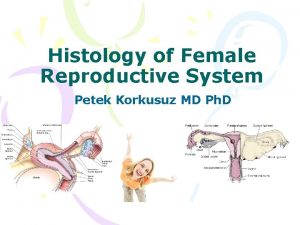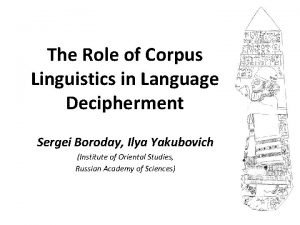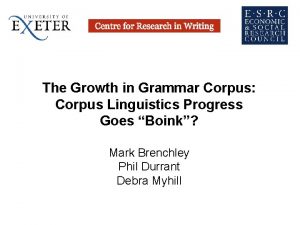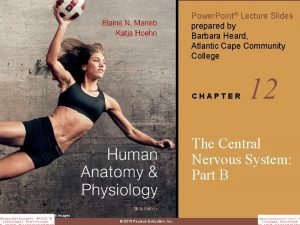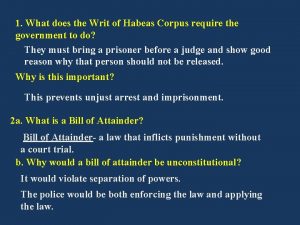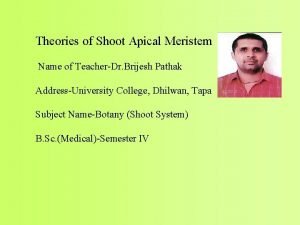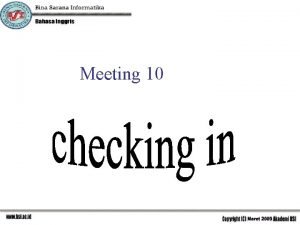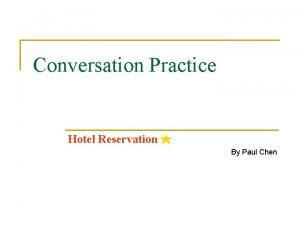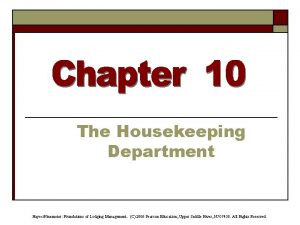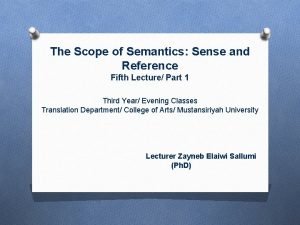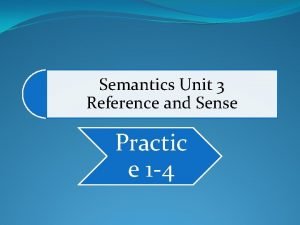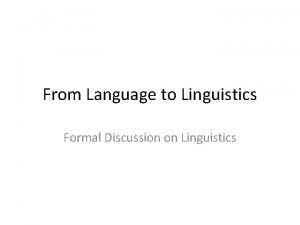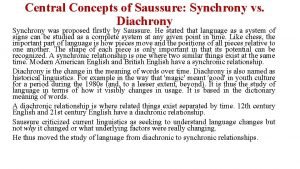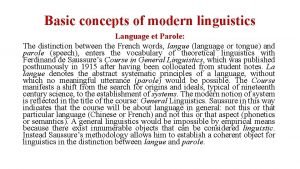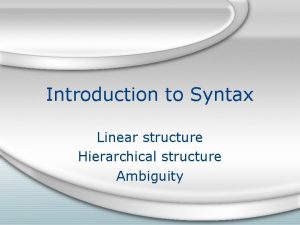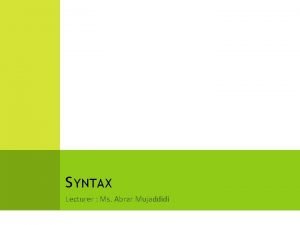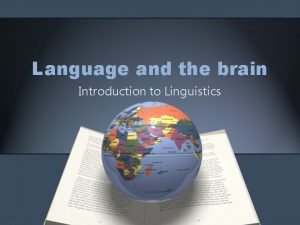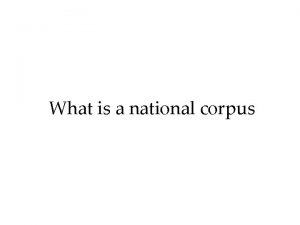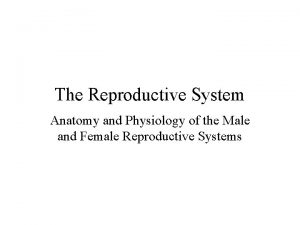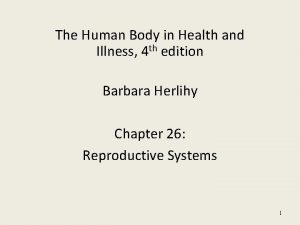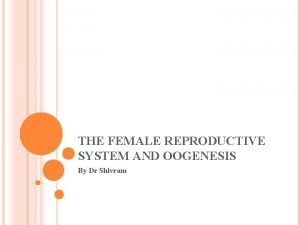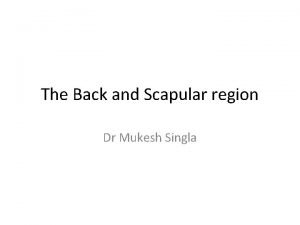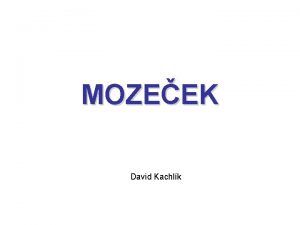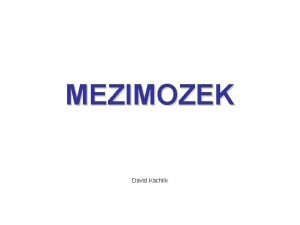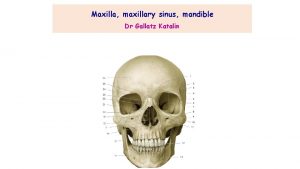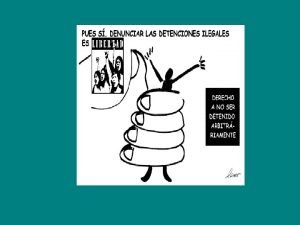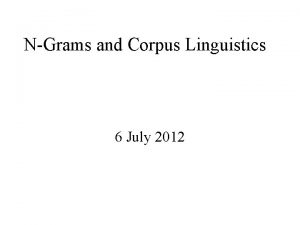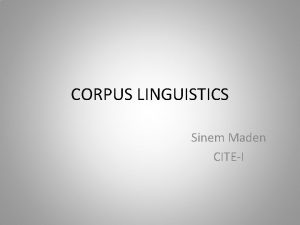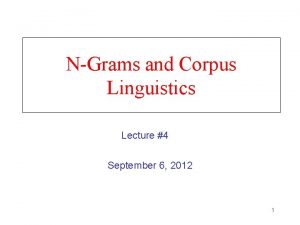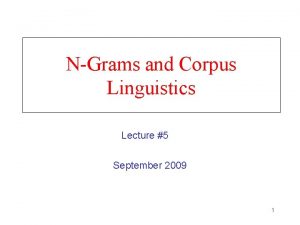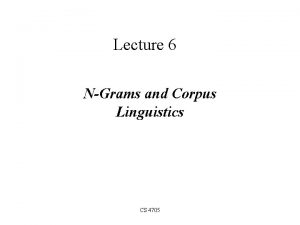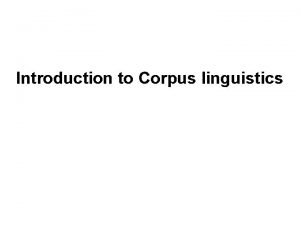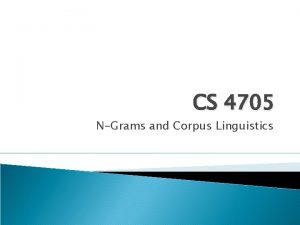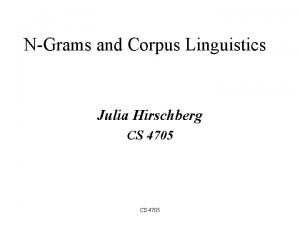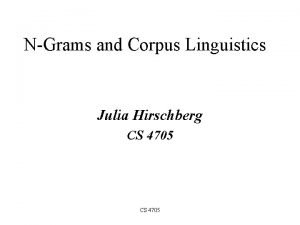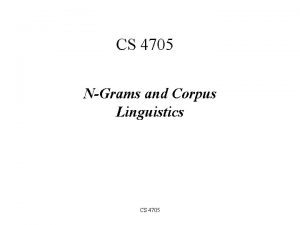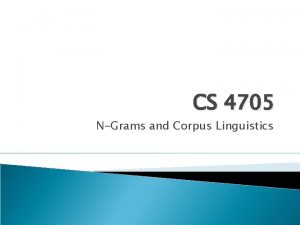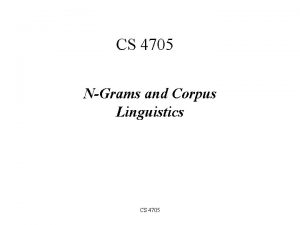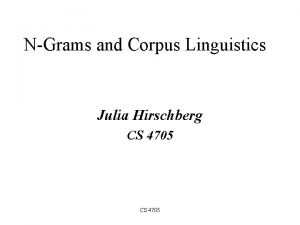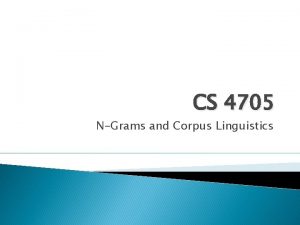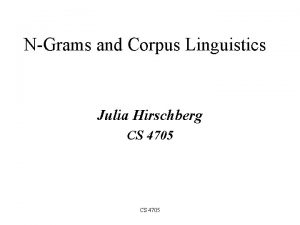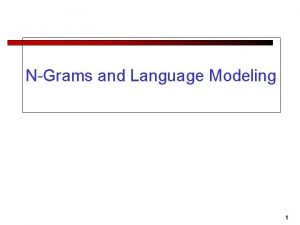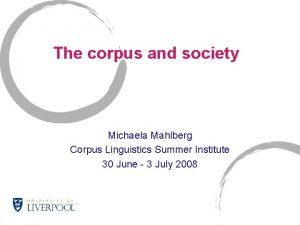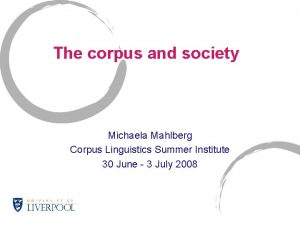Lecture 6 NGrams and Corpus Linguistics guest lecture












































- Slides: 44

Lecture 6 N-Grams and Corpus Linguistics guest lecture by Dragomir Radev radev@eecs. umich. edu radev@cs. columbia. edu CS 4705

Spelling Correction, revisited • M$ suggests: – – – – ngram: Nor. Am unigrams: anagrams, enigmas bigrams: begrimes trigrams: ? ? Markov: Mark backoff: bakeoff wn: wan, wen, win, won Falstaff: Flagstaff

Next Word Prediction • From a NY Times story. . . – Stocks plunged this …. – Stocks plunged this morning, despite a cut in interest rates by the Federal Reserve, as Wall. . . – Stocks plunged this morning, despite a cut in interest rates by the Federal Reserve, as Wall Street began

– Stocks plunged this morning, despite a cut in interest rates by the Federal Reserve, as Wall Street began trading for the first time since last … – Stocks plunged this morning, despite a cut in interest rates by the Federal Reserve, as Wall Street began trading for the first time since last Tuesday's terrorist attacks.

Human Word Prediction • Clearly, at least some of us have the ability to predict future words in an utterance. • How? – Domain knowledge – Syntactic knowledge – Lexical knowledge

Claim • A useful part of the knowledge needed to allow Word Prediction can be captured using simple statistical techniques • In particular, we'll rely on the notion of the probability of a sequence (a phrase, a sentence)

Applications • Why do we want to predict a word, given some preceding words? – Rank the likelihood of sequences containing various alternative hypotheses, e. g. for ASR Theatre owners say popcorn/unicorn sales have doubled. . . – Assess the likelihood/goodness of a sentence, e. g. for text generation or machine translation The doctor recommended a cat scan. El doctor recommendó una exploración del gato.

N-Gram Models of Language • Use the previous N-1 words in a sequence to predict the next word • Language Model (LM) – unigrams, bigrams, trigrams, … • How do we train these models? – Very large corpora

Counting Words in Corpora • What is a word? – – – e. g. , are cat and cats the same word? September and Sept? zero and oh? Is _ a word? * ? ‘(‘ ? How many words are there in don’t ? Gonna ? In Japanese and Chinese text -- how do we identify a word?

Terminology • Sentence: unit of written language • Utterance: unit of spoken language • Word Form: the inflected form that appears in the corpus • Lemma: an abstract form, shared by word forms having the same stem, part of speech, and word sense • Types: number of distinct words in a corpus (vocabulary size) • Tokens: total number of words

Corpora • Corpora are online collections of text and speech – – – Brown Corpus Wall Street Journal AP news Hansards DARPA/NIST text/speech corpora (Call Home, ATIS, switchboard, Broadcast News, TDT, Communicator) – TRAINS, Radio News

Simple N-Grams • Assume a language has V word types in its lexicon, how likely is word x to follow word y? – Simplest model of word probability: 1/V – Alternative 1: estimate likelihood of x occurring in new text based on its general frequency of occurrence estimated from a corpus (unigram probability) popcorn is more likely to occur than unicorn – Alternative 2: condition the likelihood of x occurring in the context of previous words (bigrams, trigrams, …) mythical unicorn is more likely than mythical popcorn

Computing the Probability of a Word Sequence • Compute the product of component conditional probabilities? – P(the mythical unicorn) = P(the) P(mythical|the) P(unicorn|the mythical) • The longer the sequence, the less likely we are to find it in a training corpus P(Most biologists and folklore specialists believe that in fact the mythical unicorn horns derived from the narwhal) • Solution: approximate using n-grams

Bigram Model • Approximate by – P(unicorn|the mythical) by P(unicorn|mythical) • Markov assumption: the probability of a word depends only on the probability of a limited history • Generalization: the probability of a word depends only on the probability of the n previous words – trigrams, 4 -grams, … – the higher n is, the more data needed to train – backoff models

Using N-Grams • For N-gram models – – P(wn-1, wn) = P(wn | wn-1) P(wn-1) – By the Chain Rule we can decompose a joint probability, e. g. P(w 1, w 2, w 3) P(w 1, w 2, . . . , wn) = P(w 1|w 2, w 3, . . . , wn) P(w 2|w 3, . . . , wn) … P(wn-1|wn) P(wn) For bigrams then, the probability of a sequence is just the product of the conditional probabilities of its bigrams P(the, mythical, unicorn) = P(unicorn|mythical) P(mythical|the) P(the|<start>)

Training and Testing • N-Gram probabilities come from a training corpus – overly narrow corpus: probabilities don't generalize – overly general corpus: probabilities don't reflect task or domain • A separate test corpus is used to evaluate the model, typically using standard metrics – held out test set; development test set – cross validation – results tested for statistical significance

A Simple Example – P(I want to each Chinese food) = P(I | <start>) P(want | I) P(to | want) P(eat | to) P(Chinese | eat) P(food | Chinese)

A Bigram Grammar Fragment from BERP Eat on . 16 Eat Thai . 03 Eat some . 06 Eat breakfast . 03 Eat lunch . 06 Eat in . 02 Eat dinner . 05 Eat Chinese . 02 Eat at . 04 Eat Mexican . 02 Eat a . 04 Eat tomorrow. 01 Eat Indian . 04 Eat dessert . 007 Eat today . 03 Eat British . 001

<start> I’d <start> Tell <start> I’m I want I would I don’t I have Want to . 25. 06. 04. 02. 32. 29. 08. 04. 65 Want some Want Thai To eat To have To spend To be British food British restaurant British cuisine . 04. 01. 26. 14. 09. 02. 60. 15. 01 Want a . 05 British lunch . 01

• P(I want to eat British food) = P(I|<start>) P(want|I) P(to|want) P(eat|to) P(British|eat) P(food|British) =. 25*. 32*. 65*. 26*. 001*. 60 =. 000080 • vs. I want to eat Chinese food =. 00015 • Probabilities seem to capture ``syntactic'' facts, ``world knowledge'' – eat is often followed by an NP – British food is not too popular • N-gram models can be trained by counting and normalization

BERP Bigram Counts I Want To Eat Chinese Food lunch I 8 1087 0 13 0 0 0 Want 3 0 786 0 6 8 6 To 3 0 10 860 3 0 12 Eat 0 0 2 0 19 2 52 Chinese 2 0 0 120 1 Food 19 0 17 0 0 Lunch 4 0 0 1 0

BERP Bigram Probabilities • Normalization: divide each row's counts by appropriate unigram counts for wn-1 I Want 3437 1215 To Eat Chinese 3256 938 213 Food Lunch 1506 459 • Computing the bigram probability of I I – C(I, I)/C(all I) – p (I|I) = 8 / 3437 =. 0023 • Maximum Likelihood Estimation (MLE): relative frequency of e. g.

Maximum likelihood estimation (MLE) • Assuming a binomial distribution f(s; n, p) Adapted from Ewa Wosik

Maximum likelihood estimation (MLE) L(p) = L(p; x 1, x 2, . . . , xn) = f(x 1; p) f(x 2; p) ··· f(xn; p) = ps (1−p)n−s , 0≤p≤ 1, where s is the observed count = ∑xi To find the value of p for which L(p) is minimized: d. L(p)/dp = spn−s (1−p)n−s − (n−s) ps (1−p)n−s− 1 ps (1−p)n−s [s/p − (n−s)/(1−p)] = 0 s/p − (n−s)/(1−p) = 0, for 0<p<1 p = s/n = xavg pest = s/n = Xavg is the MLE (maximum likelihood estimator) In log space: ln L(p) = s ln p + (n−s) ln (1−p) d[ln L(p)]/dp = s/p + (n−s)(− 1/(1−p)) = 0, for 0<p<1 Adapted from Ewa Wosik

What do we learn about the language? • What's being captured with. . . – – – P(want | I) =. 32 P(to | want) =. 65 P(eat | to) =. 26 P(food | Chinese) =. 56 P(lunch | eat) =. 055 • What about. . . – P(I | I) =. 0023 – P(I | want) =. 0025 – P(I | food) =. 013

– P(I | I) =. 0023 I I want – P(I | want) =. 0025 I want – P(I | food) =. 013 the kind of food I want is. . .

Approximating Shakespeare • As we increase the value of N, the accuracy of the n-gram model increases, since choice of next word becomes increasingly constrained • Generating sentences with random unigrams. . . – Every enter now severally so, let – Hill he late speaks; or! a more to leg less first you enter • With bigrams. . . – What means, sir. I confess she? then all sorts, he is trim, captain. – Why dost stand forth thy canopy, forsooth; he is this palpable hit the King Henry.

• Trigrams – Sweet prince, Falstaff shall die. – This shall forbid it should be branded, if renown made it empty. • Quadrigrams – What! I will go seek the traitor Gloucester. – Will you not tell me who I am?

Demo • Anoop Sarkar’s trigen (using the Wall Street Journal corpus) Reagan must make a hostile tender offer. Prime recently has skipped several major exercise-equipment trade shows ; competitors consider that a sign of a generous U. S. farm legislation rather than hanged , the accordion was inextricably linked with iron to large structural spending cuts , I can do a better retirement package and profit-sharing arrangements. The only way an individual should play well with the American Orchid Society , but understandable. '' Since last year were charged to a 1933 law , banks must report any cash transaction of $ 2. 06 billion. In addition , Mr. Spence said. `` You strangle the guys with trench coats -LRB- all -RRBover us. If the commission 's co-chairman , said the market for the children while Mrs. Quayle campaigned , but in a breach-of-contract lawsuit against Nautilus. Some traders said the ruling means `` testing is permitted and we 're friends , '' he said is `` anxious to get Master. Card back on track , '' Jaime Martorell Suarez says proudly.

• There are 884, 647 tokens, with 29, 066 word form types, in about a one million word Shakespeare corpus • Shakespeare produced 300, 000 bigram types out of 844 million possible bigrams: so, 99. 96% of the possible bigrams were never seen (have zero entries in the table) • Quadrigrams worse: What's coming out looks like Shakespeare because it is Shakespeare

N-Gram Training Sensitivity • If we repeated the Shakespeare experiment but trained our n-grams on a Wall Street Journal corpus, what would we get? • This has major implications for corpus selection or design

Some Useful Empirical Observations • A small number of events occur with high frequency • A large number of events occur with low frequency • You can quickly collect statistics on the high frequency events • You might have to wait an arbitrarily long time to get valid statistics on low frequency events • Some of the zeroes in the table are really zeros But others are simply low frequency events you haven't seen yet. How to address?

Smoothing Techniques • Every n-gram training matrix is sparse, even for very large corpora (Zipf’s law) • Solution: estimate the likelihood of unseen ngrams • Problems: how do you adjust the rest of the corpus to accommodate these ‘phantom’ n-grams?

Add-one Smoothing • For unigrams: – Add 1 to every word (type) count – Normalize by N (tokens) /(N (tokens) +V (types)) – Smoothed count (adjusted for additions to N) is – Normalize by N to get the new unigram probability: • For bigrams: – Add 1 to every bigram c(wn-1 wn) + 1 – Incr unigram count by vocabulary size c(wn-1) + V

– Discount: ratio of new counts to old (e. g. add-one smoothing changes the BERP bigram (to|want) from 786 to 331 (dc=. 42) and p(to|want) from. 65 to. 28) – But this changes counts drastically: • too much weight given to unseen ngrams • in practice, unsmoothed bigrams often work better!

Witten-Bell Discounting • A zero ngram is just an ngram you haven’t seen yet…but every ngram in the corpus was unseen once…so. . . – How many times did we see an ngram for the first time? Once for each ngram type (T) – Est. total probability of unseen bigrams as – View training corpus as series of events, one for each token (N) and one for each new type (T)

– We can divide the probability mass equally among unseen bigrams…. or we can condition the probability of an unseen bigram on the first word of the bigram – Discount values for Witten-Bell are much more reasonable than Add-One

Backoff methods (e. g. Katz ‘ 87) • For e. g. a trigram model – Compute unigram, bigram and trigram probabilities – In use: • Where trigram unavailable back off to bigram if available, o. w. unigram probability • E. g An omnivorous unicorn

More advanced language models • Adaptive LM: condition probabilities on the history • Class-based LM: collapse multiple words into a single class • Syntax-based LM: use the syntactic structure of the sentence • Bursty LM: use different probabilities for content and non-content words. Example: p(ct(Noriega)>1) | p(ct(Noriega)>0)?

Evaluating language models • Perplexity – describes the ease of making a prediction. Lower perplexity = easier prediction • Example 1: P(1/4, 1/4) = ? • Example 2: P(1/2, 1/4, 1/8) = ?

LM toolkits • The CMU-Cambridge LM toolkit (CMULM) – http: //www. speech. cs. cmu. edu/SLM/toolkit. html • The SRILM toolkit – http: //www. speech. sri. com/projects/srilm/ • Demo of CMULM: cat austen. txt | text 2 wfreq >|a. wfreq cat austen. txt | text 2 wngram -n 3 -temp /tmp >|a. w 3 gram cat austen. txt | text 2 idngram -n 3 -vocab a. vocab -temp /tmp >| a. id 3 gram idngram 2 lm -idngram a. id 3 gram -vocab a. vocab -n 3 -binary a. gt 3 binlm evallm -binary a. gt 3 binlm perplexity -text ja-pers-clean. txt

New course to be offered in January 2007!! • COMS 6998 Search Engine Technology (Radev) 1. 2. 3. 4. 5. 6. 7. 8. 9. 10. 11. 12. 13. 14. 15. Models of Information retrieval. The Vector model. The Boolean model. Storing, indexing and searching text. Inverted indexes. TF*IDF. Retrieval Evaluation. Precision and Recall. F-measure. Reference collections. The TREC conferences. Queries and Documents. Query Languages. Document preprocessing. Tokenization. Stemming. The Porter algorithm. Word distributions. The Zipf distribution. The Benford distribution. Relevance feedback and query expansion. String matching. Approximate matching. Compression and coding. Optimal codes. Vector space similarity and clustering. k-means clustering. EM clustering. Text classification. Linear classifiers. k-nearest neighbors. Naive Bayes. Maximum margin classifiers. Support vector machines. Singular value decomposition and Latent Semantic Indexing. Probabilistic models of IR. Document models. Language models. Burstiness.

New course to be offered in January 2007!! • COMS 6998 Search Engine Technology (Radev) 16. Crawling the Web. Hyperlink analysis. Measuring the Web. 17. Hypertext retrieval. Web-based IR. Document closures. 18. Random graph models. Properties of random graphs: clustering coefficient, betweenness, diameter, giant connected component, degree distribution. 19. Social network analysis. Small worlds and scale-free networks. Power law distributions. 20. Models of the Web. The Bow-tie model. 21. Graph-based methods. Harmonic functions. Random walks. Page. Rank. 22. Hubs and authorities. HITS and SALSA. Bipartite graphs. 23. Webometrics. Measuring the size of the Web. 24. Focused crawling. Resource discovery. Discovering communities. 25. Collaborative filtering. Recommendation systems. 26. Information extraction. Hidden Markov Models. Conditional Random Fields. 27. Adversarial IR. Spamming and anti-spamming methods. 28. Additional topics, e. g. , natural language processing, XML retrieval, text tiling, text summarization, question answering, spectral clustering, human behavior on the web, semi-supervised learning

Summary • N-grams • N-gram probabilities can be used to estimate the likelihood – Of a word occurring in a context (N-1) – Of a sentence occurring at all • Maximum likelihood estimation • Smoothing techniques deal with problems of unseen words in corpus; also backoff • Perplexity
 Lymphatic drainage of breast
Lymphatic drainage of breast Corpus luteum histology
Corpus luteum histology Language
Language History of applied linguistics
History of applied linguistics Types of corpora
Types of corpora Corpus linguistics
Corpus linguistics Corpus linguistics
Corpus linguistics Maxims of annotation in corpus linguistics
Maxims of annotation in corpus linguistics 01:640:244 lecture notes - lecture 15: plat, idah, farad
01:640:244 lecture notes - lecture 15: plat, idah, farad Function medulla oblongata
Function medulla oblongata Z brain
Z brain The writ of habeas corpus and the grand jury both
The writ of habeas corpus and the grand jury both Figurative language slideshare
Figurative language slideshare Tunica corpus theory
Tunica corpus theory Provide valet services to guests
Provide valet services to guests Receptionist dialogue
Receptionist dialogue Guest arrival and departure procedure
Guest arrival and departure procedure Sample dialogue for making reservation
Sample dialogue for making reservation Greeting guest
Greeting guest Guest laundry docket
Guest laundry docket Opl stands for in housekeeping
Opl stands for in housekeeping Sense definition in semantics
Sense definition in semantics Example of constant reference in semantics
Example of constant reference in semantics What is linguistics
What is linguistics Special lexicology
Special lexicology Generative linguistics and cognitive psychology
Generative linguistics and cognitive psychology Synchronic vs diachronic
Synchronic vs diachronic Parole definition in linguistics
Parole definition in linguistics Structural ambiguity nedir
Structural ambiguity nedir Deep and surface structure
Deep and surface structure Language and the brain in linguistics
Language and the brain in linguistics Surface and deep structure
Surface and deep structure Armenian national corpus
Armenian national corpus Corpus luteum secretes
Corpus luteum secretes Corpus luteum secretes
Corpus luteum secretes Oogenesis
Oogenesis Movements of scapula
Movements of scapula Pharyngea ascendens
Pharyngea ascendens Fossa interpeduncularis
Fossa interpeduncularis Tractus vestibulocerebellaris
Tractus vestibulocerebellaris Mezimozek funkce
Mezimozek funkce Retromylohyoid area
Retromylohyoid area Corpus müzesi hollanda
Corpus müzesi hollanda Gigesto
Gigesto Amparo habeas corpus
Amparo habeas corpus

